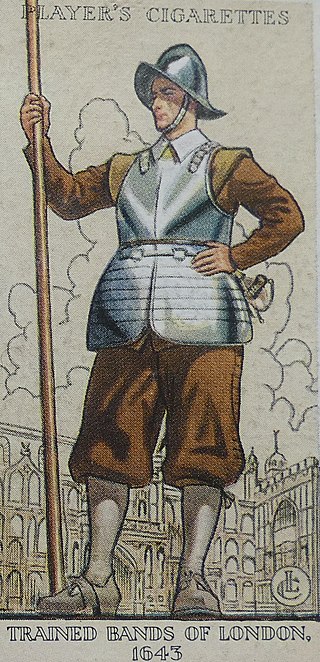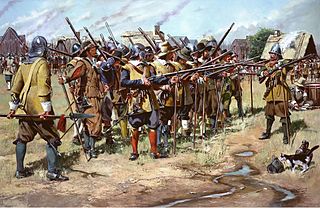
A militia is generally an army or some other fighting organization of non-professional or part-time soldiers; citizens of a country, or subjects of a state, who may perform military service during a time of need, as opposed to a professional force of regular, full-time military personnel; or, historically, to members of a warrior-nobility class. When acting independently, militias are generally unable to hold ground against regular forces; militias commonly support regular troops by skirmishing, holding fortifications, or conducting irregular warfare, instead of undertaking offensive campaigns by themselves. Local civilian laws often limit militias to serve only in their home region, and to serve only for a limited time; this further reduces their use in long military campaigns. Militias may also, however, serve as a pool of available manpower for regular forces to draw from, particularly in emergencies.
The French and Indian Wars were a series of conflicts that occurred in North America between 1688 and 1763, some of which indirectly were related to the European dynastic wars. The title French and Indian War in the singular is used in the United States specifically for the warfare of 1754–63, which composed the North American theatre of the Seven Years' War and the aftermath of which led to the American Revolution. The French and Indian Wars were preceded by the Beaver Wars.

A regiment is a military unit. Its role and size varies markedly, depending on the country, service, or specialisation.
The colonial militias in Canada were made up of various militias prior to Confederation in 1867. During the period of New France and Acadia, Newfoundland Colony, and Nova Scotia (1605–1763), these militias were made up of Canadiens, First Nations, British and Acadians. Traditionally, the Canadian Militia was the name used for the local sedentary militia regiments throughout the Canadas.

The Regular Army of the United States succeeded the Continental Army as the country's permanent, professional land-based military force. In modern times, the professional core of the United States Army continues to be called the Regular Army. From the time of the American Revolution until after the Spanish–American War, state militias and volunteer regiments organized by the states supported the smaller Regular Army of the United States. These volunteer regiments came to be called United States Volunteers (USV) in contrast to the Regular United States Army (USA). During the American Civil War, about 97 percent of the Union Army was United States Volunteers.

The militia of the United States, as defined by the U.S. Congress, has changed over time. During colonial America, all able-bodied men of a certain age range were members of the militia, depending on each colony's rule. Individual towns formed local independent militias for their own defense. The year before the U.S. Constitution was ratified, The Federalist Papers detailed the Founding Fathers' paramount vision of the militia in 1787. The new Constitution empowered Congress to "organize, arm, and discipline" this national military force, leaving significant control in the hands of each state government.

The Battles of Lexington and Concord was the first major military campaign of the American Revolutionary War, resulting in an American victory and outpouring of militia support for the anti-British cause. The battles were fought on April 19, 1775, in Middlesex County, Province of Massachusetts Bay, within the towns of Lexington, Concord, Lincoln, Menotomy, and Cambridge. They marked the outbreak of armed conflict between the Kingdom of Great Britain and Patriot militias from America's thirteen colonies.

The Massachusetts National Guard is the National Guard component for the Commonwealth of Massachusetts. Founded as the Massachusetts Bay Colonial Militia on December 13, 1636, it contains the oldest units in the United States Army. What is today's Massachusetts National Guard evolved through many different forms. Originally founded as a defensive militia for Puritan colonists in the Massachusetts Bay Colony, the militia evolved into a highly organized and armed fighting force. The Massachusetts militia served as a central organ of the New England revolutionary fighting force during the early American Revolution and a major component in the Continental Army under George Washington.
The Canadian Militia is a historical title for military units raised for the defence of Canada. The term has been used to describe sedentary militia units raised from local communities in Canada; as well as the regular army for the Province of Canada and post-confederated Canada, referred to as the active militias.

Trained Bands were companies of part-time militia in England and Wales. Organised by county, they were supposed to drill on a regular basis, although this was rarely the case in practice. The regular army was formed from the Trained Bands in the event of war, though the inability or unwillingness of many of the bands to serve outside of their home regions often left the army short on manpower compared to the paper strength implied by the Trained Bands rolls. They later became common in the American colonies, where they are normally referred to as Trainbands. Similar organisations include the Dutch Schutterij, and the Swiss militia, elements of which remain in existence today.

The English Militia was the principal military reserve force of the Kingdom of England. Militia units were repeatedly raised in England from the Anglo-Saxon period onwards for internal security duties and to defend against external invasions. One of the first militia units in England were the fyrd, which were raised from freemen to defend the estate of their local Shire's lord or accompany the housecarls on offensive expeditions. During the Middle Ages, English militia units continued to be raised for service in various conflicts such as the Wars of Scottish Independence, the Hundred Years' War and the Wars of the Roses. Militia troops continued to see service in Tudor and Stuart periods, most prominently in the Wars of the Three Kingdoms. Following the Acts of Union 1707, the English Militia was transformed into the British Militia.

Minutemen were members of the organized New England colonial militia companies trained in weaponry, tactics, and military strategies during the American Revolutionary War. They were known for being ready at a minute's notice, hence the name. Minutemen provided a highly mobile, rapidly deployed force that enabled the colonies to respond immediately to military threats. They were an evolution from the prior colonial rapid-response units.

The units of the Arkansas Militia in the Civil War to which the current Arkansas National Guard has a connection include the Arkansas State Militia, Home Guard, and State Troop regiments raised by the State of Arkansas. Like most of the United States, Arkansas had an organized militia system before the American Civil War. State law required military service of most male inhabitants of a certain age. Following the War with Mexico, the Arkansas militia experienced a decline, but as sectional frictions between the north and south began to build in the late 1850s the militia experienced a revival. By 1860 the state's militia consisted of 62 regiments divided into eight brigades, which comprised an eastern division and a western division. New regiments were added as the militia organization developed. Additionally, many counties and cities raised uniformed volunteer companies, which drilled more often and were better equipped than the un-uniformed militia. These volunteer companies were instrumental in the seizure of federal installations at Little Rock and Fort Smith, beginning in February 1861.

The Norfolk Militia was an auxiliary military force in the English county of Norfolk in East Anglia. From their formal organisation as Trained Bands in 1558 until their final service as the Special Reserve, the Militia regiments of the county carried out internal security and home defence duties in all of Britain's major wars. They saw active service during the Bishops' Wars, the English Civil Wars and the Second Boer War, and finally trained thousands of reinforcements during World War I. After a shadowy postwar existence they were formally disbanded in 1953.

The Royal Guernsey Militia has a history dating back 800 years. Always loyal to the British Crown, the men were unpaid volunteers whose wish was to defend the Island of Guernsey from foreign invaders.
The Maltese Militia or Malta Militia was a militia unit in the British Army which existed from 1801 to 1802, and again from 1852 to 1857. The first incarnation was a volunteer unit of 900 men raised in the British protectorate of Malta. The second establishment of the militia was as a compulsory service for the entire Maltese male population while the island was a British crown colony.
The Devon Militia was a part-time military force in the maritime county of Devonshire in the West of England. From their formal organisation as Trained Bands in 1558 until their final service as a Special Reserve unit of the Devonshire Regiment in World War I, the Militia regiments of Devonshire served in home defence in all of Britain's major wars.
The Gloucestershire Militia was a part-time military force in the county of Gloucestershire in the West of England. From their formal organisation as Trained Bands in 1558 until their final service as a Special Reserve unit of the Gloucestershire Regiment in World War I, the Militia regiments of the county served in home defence in all of Britain's major wars.
The Carnarvonshire Militia, later the Royal Carnarvon Rifles, was an auxiliary regiment reorganised in the county of Caernarfonshire in North Wales during the 18th Century from earlier precursor units. Primarily intended for home defence, it served in Britain and Ireland through all Britain's major wars until it was disbanded in 1908.












